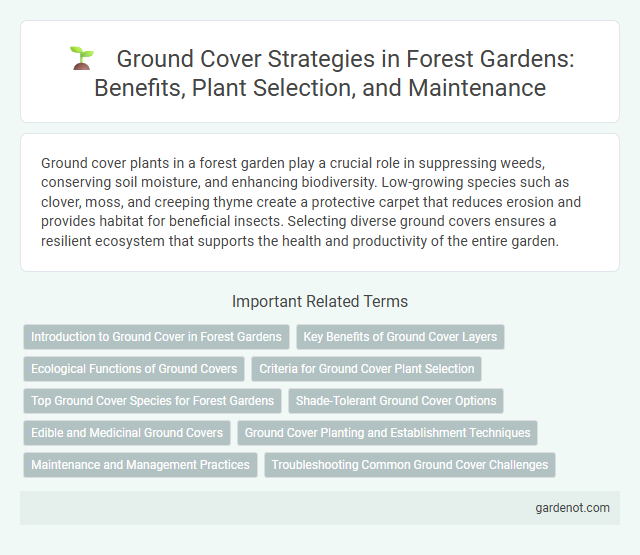Ground cover plants in a forest garden play a crucial role in suppressing weeds, conserving soil moisture, and enhancing biodiversity. Low-growing species such as clover, moss, and creeping thyme create a protective carpet that reduces erosion and provides habitat for beneficial insects. Selecting diverse ground covers ensures a resilient ecosystem that supports the health and productivity of the entire garden.
Introduction to Ground Cover in Forest Gardens
Ground cover plants in forest gardens play a crucial role by protecting soil from erosion, retaining moisture, and suppressing weeds, creating a stable and fertile environment for other plants. These low-growing species, often including clover, strawberries, and creeping thyme, contribute to biodiversity and enhance nutrient cycling through nitrogen fixation and organic matter addition. Integrating diverse ground cover supports ecosystem health, improves soil structure, and fosters resilient forest garden systems.
Key Benefits of Ground Cover Layers
Ground cover layers in a forest garden play a critical role in soil moisture retention, weed suppression, and erosion control, enhancing overall ecosystem resilience. By creating a dense mat of vegetation, ground covers improve soil fertility through organic matter decomposition while supporting beneficial soil microorganisms. These layers also provide habitat for pollinators and pest predators, contributing to balanced biodiversity and healthier plant growth.
Ecological Functions of Ground Covers
Ground covers in forest gardens play a crucial role in preventing soil erosion by stabilizing the soil with their extensive root systems. They enhance soil fertility through nitrogen fixation and organic matter contribution, supporting nutrient cycling essential for plant health. These low-growing plants also provide habitats for beneficial insects and microorganisms, promoting biodiversity and natural pest control within the ecosystem.
Criteria for Ground Cover Plant Selection
Effective ground cover plants in forest gardens must demonstrate shade tolerance, rapid soil stabilization, and minimal maintenance requirements. Selecting species with deep root systems enhances erosion control and nutrient cycling, while their ability to suppress weeds reduces competition for mature plants. Optimal ground covers also contribute to biodiversity by providing habitat for beneficial insects and improving soil organic matter.
Top Ground Cover Species for Forest Gardens
Top ground cover species for forest gardens include sweet woodruff (Galium odoratum), wild ginger (Asarum canadense), and creeping thyme (Thymus serpyllum), all known for their dense foliage and soil protection. These species enhance soil moisture retention, suppress weeds, and contribute to biodiversity by supporting pollinators and beneficial insects. Selecting native and shade-tolerant ground covers ensures long-term ecosystem stability and reduces maintenance in forest garden systems.
Shade-Tolerant Ground Cover Options
Shade-tolerant ground cover options for forest gardens include native plants such as wild ginger (Asarum canadense), sweet woodruff (Galium odoratum), and creeping thyme (Thymus serpyllum), which thrive under dense tree canopies. These species help prevent soil erosion, suppress weeds, and contribute to soil health by enhancing organic matter. Selecting shade-adapted ground covers supports biodiversity and maintains moisture levels essential for a sustainable forest garden ecosystem.
Edible and Medicinal Ground Covers
Edible and medicinal ground covers like wild strawberries (Fragaria vesca), creeping thyme (Thymus serpyllum), and wood sorrel (Oxalis acetosella) enrich forest gardens by suppressing weeds and enhancing soil health through natural nitrogen fixation. These low-growing plants provide a continuous harvest of nutritious fruits, aromatic herbs, and healing leaves while supporting beneficial insect populations and moisture retention. Integrating diverse ground covers optimizes forest garden productivity, resilience, and ecosystem balance.
Ground Cover Planting and Establishment Techniques
Ground cover planting in forest gardens enhances soil stability, moisture retention, and weed suppression by creating a dense, living mulch layer. Techniques such as early soil preparation, mulching, and careful selection of shade-tolerant species like clover, creeping thyme, and wild ginger ensure rapid establishment and long-term ground cover effectiveness. Proper spacing and regular monitoring during establishment support healthy growth, preventing soil erosion and promoting biodiversity within the forest garden ecosystem.
Maintenance and Management Practices
Effective maintenance and management of ground cover in forest gardens involve regular monitoring to prevent invasive species and ensure healthy soil moisture levels. Mulching with organic materials conserves water, suppresses weeds, and enriches soil fertility, reducing the need for chemical inputs. Periodic trimming and controlled grazing help maintain plant diversity and promote robust ground cover that supports overall ecosystem health.
Troubleshooting Common Ground Cover Challenges
Ground cover in forest gardens often faces challenges such as poor soil drainage, invasive weed competition, and insufficient sunlight exposure. To troubleshoot, improve soil aeration by adding organic mulch, regularly remove aggressive weeds to prevent domination, and select shade-tolerant species tailored to local light conditions. Monitoring moisture levels and adjusting irrigation schedules helps maintain optimal growth and ground cover density.
Ground cover Infographic

 gardenot.com
gardenot.com